Contemporary Indigenous Health and Well Being | Report
VerifiedAdded on 2022/09/18
|8
|2270
|25
AI Summary
Contribute Materials
Your contribution can guide someone’s learning journey. Share your
documents today.
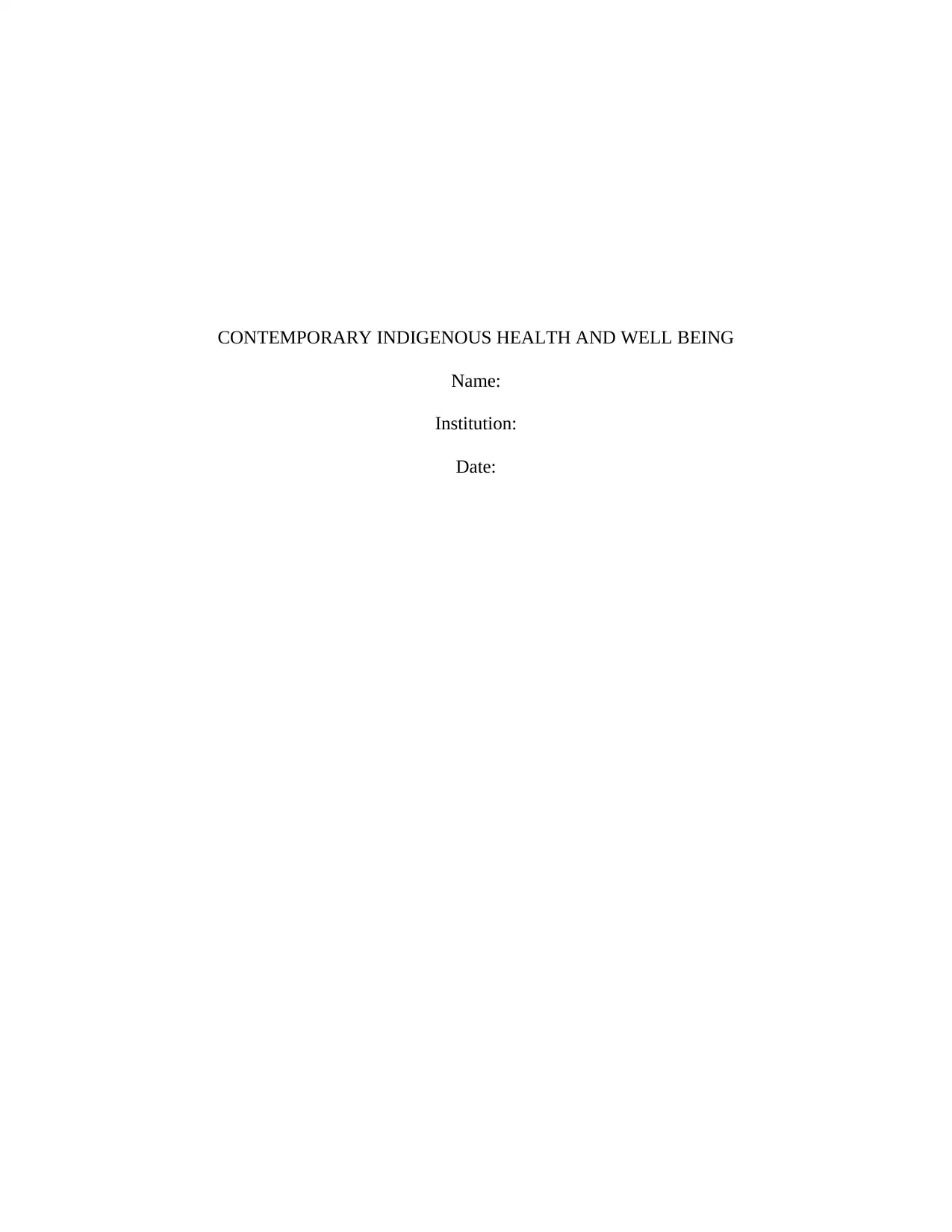
CONTEMPORARY INDIGENOUS HEALTH AND WELL BEING
Name:
Institution:
Date:
Name:
Institution:
Date:
Secure Best Marks with AI Grader
Need help grading? Try our AI Grader for instant feedback on your assignments.
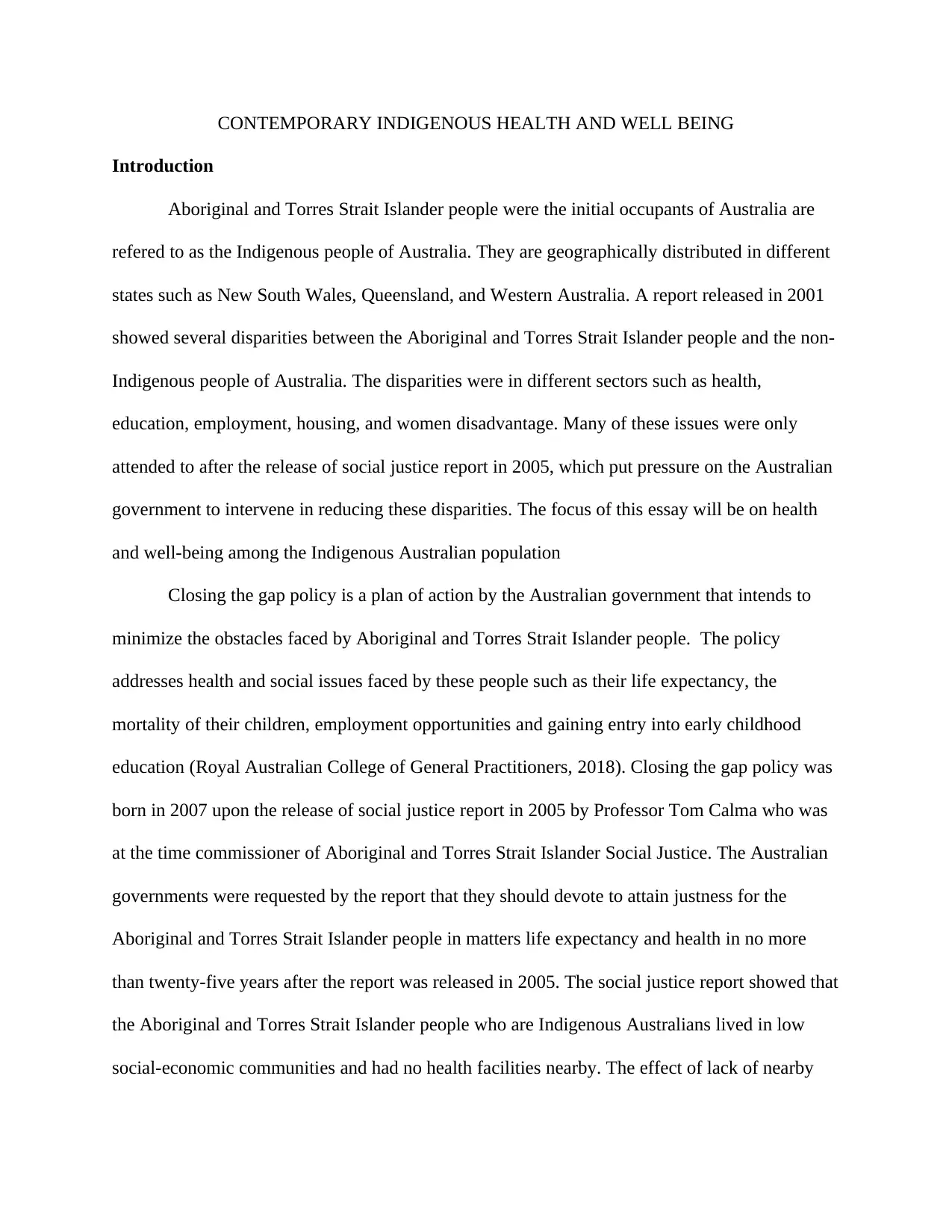
CONTEMPORARY INDIGENOUS HEALTH AND WELL BEING
Introduction
Aboriginal and Torres Strait Islander people were the initial occupants of Australia are
refered to as the Indigenous people of Australia. They are geographically distributed in different
states such as New South Wales, Queensland, and Western Australia. A report released in 2001
showed several disparities between the Aboriginal and Torres Strait Islander people and the non-
Indigenous people of Australia. The disparities were in different sectors such as health,
education, employment, housing, and women disadvantage. Many of these issues were only
attended to after the release of social justice report in 2005, which put pressure on the Australian
government to intervene in reducing these disparities. The focus of this essay will be on health
and well-being among the Indigenous Australian population
Closing the gap policy is a plan of action by the Australian government that intends to
minimize the obstacles faced by Aboriginal and Torres Strait Islander people. The policy
addresses health and social issues faced by these people such as their life expectancy, the
mortality of their children, employment opportunities and gaining entry into early childhood
education (Royal Australian College of General Practitioners, 2018). Closing the gap policy was
born in 2007 upon the release of social justice report in 2005 by Professor Tom Calma who was
at the time commissioner of Aboriginal and Torres Strait Islander Social Justice. The Australian
governments were requested by the report that they should devote to attain justness for the
Aboriginal and Torres Strait Islander people in matters life expectancy and health in no more
than twenty-five years after the report was released in 2005. The social justice report showed that
the Aboriginal and Torres Strait Islander people who are Indigenous Australians lived in low
social-economic communities and had no health facilities nearby. The effect of lack of nearby
Introduction
Aboriginal and Torres Strait Islander people were the initial occupants of Australia are
refered to as the Indigenous people of Australia. They are geographically distributed in different
states such as New South Wales, Queensland, and Western Australia. A report released in 2001
showed several disparities between the Aboriginal and Torres Strait Islander people and the non-
Indigenous people of Australia. The disparities were in different sectors such as health,
education, employment, housing, and women disadvantage. Many of these issues were only
attended to after the release of social justice report in 2005, which put pressure on the Australian
government to intervene in reducing these disparities. The focus of this essay will be on health
and well-being among the Indigenous Australian population
Closing the gap policy is a plan of action by the Australian government that intends to
minimize the obstacles faced by Aboriginal and Torres Strait Islander people. The policy
addresses health and social issues faced by these people such as their life expectancy, the
mortality of their children, employment opportunities and gaining entry into early childhood
education (Royal Australian College of General Practitioners, 2018). Closing the gap policy was
born in 2007 upon the release of social justice report in 2005 by Professor Tom Calma who was
at the time commissioner of Aboriginal and Torres Strait Islander Social Justice. The Australian
governments were requested by the report that they should devote to attain justness for the
Aboriginal and Torres Strait Islander people in matters life expectancy and health in no more
than twenty-five years after the report was released in 2005. The social justice report showed that
the Aboriginal and Torres Strait Islander people who are Indigenous Australians lived in low
social-economic communities and had no health facilities nearby. The effect of lack of nearby
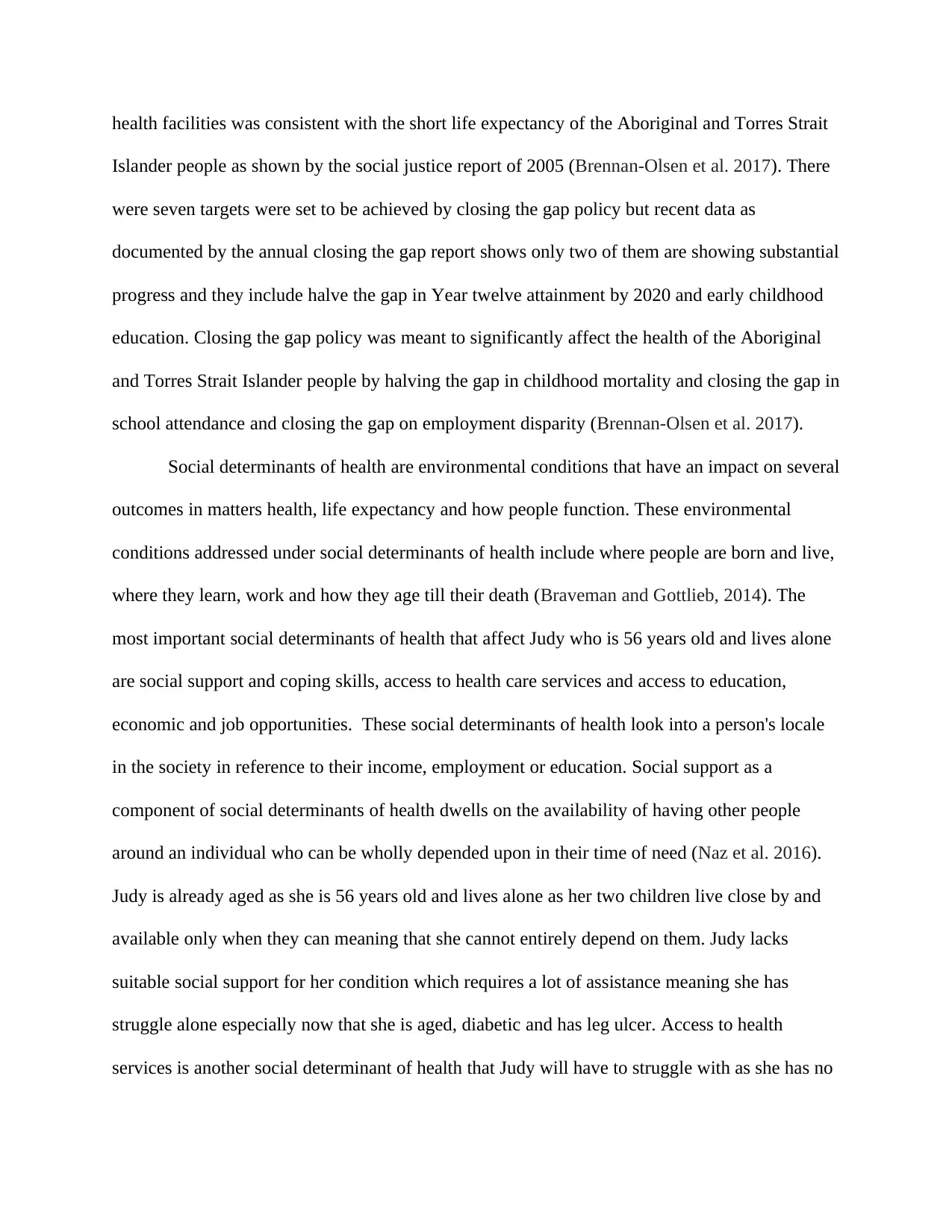
health facilities was consistent with the short life expectancy of the Aboriginal and Torres Strait
Islander people as shown by the social justice report of 2005 (Brennan-Olsen et al. 2017). There
were seven targets were set to be achieved by closing the gap policy but recent data as
documented by the annual closing the gap report shows only two of them are showing substantial
progress and they include halve the gap in Year twelve attainment by 2020 and early childhood
education. Closing the gap policy was meant to significantly affect the health of the Aboriginal
and Torres Strait Islander people by halving the gap in childhood mortality and closing the gap in
school attendance and closing the gap on employment disparity (Brennan-Olsen et al. 2017).
Social determinants of health are environmental conditions that have an impact on several
outcomes in matters health, life expectancy and how people function. These environmental
conditions addressed under social determinants of health include where people are born and live,
where they learn, work and how they age till their death (Braveman and Gottlieb, 2014). The
most important social determinants of health that affect Judy who is 56 years old and lives alone
are social support and coping skills, access to health care services and access to education,
economic and job opportunities. These social determinants of health look into a person's locale
in the society in reference to their income, employment or education. Social support as a
component of social determinants of health dwells on the availability of having other people
around an individual who can be wholly depended upon in their time of need (Naz et al. 2016).
Judy is already aged as she is 56 years old and lives alone as her two children live close by and
available only when they can meaning that she cannot entirely depend on them. Judy lacks
suitable social support for her condition which requires a lot of assistance meaning she has
struggle alone especially now that she is aged, diabetic and has leg ulcer. Access to health
services is another social determinant of health that Judy will have to struggle with as she has no
Islander people as shown by the social justice report of 2005 (Brennan-Olsen et al. 2017). There
were seven targets were set to be achieved by closing the gap policy but recent data as
documented by the annual closing the gap report shows only two of them are showing substantial
progress and they include halve the gap in Year twelve attainment by 2020 and early childhood
education. Closing the gap policy was meant to significantly affect the health of the Aboriginal
and Torres Strait Islander people by halving the gap in childhood mortality and closing the gap in
school attendance and closing the gap on employment disparity (Brennan-Olsen et al. 2017).
Social determinants of health are environmental conditions that have an impact on several
outcomes in matters health, life expectancy and how people function. These environmental
conditions addressed under social determinants of health include where people are born and live,
where they learn, work and how they age till their death (Braveman and Gottlieb, 2014). The
most important social determinants of health that affect Judy who is 56 years old and lives alone
are social support and coping skills, access to health care services and access to education,
economic and job opportunities. These social determinants of health look into a person's locale
in the society in reference to their income, employment or education. Social support as a
component of social determinants of health dwells on the availability of having other people
around an individual who can be wholly depended upon in their time of need (Naz et al. 2016).
Judy is already aged as she is 56 years old and lives alone as her two children live close by and
available only when they can meaning that she cannot entirely depend on them. Judy lacks
suitable social support for her condition which requires a lot of assistance meaning she has
struggle alone especially now that she is aged, diabetic and has leg ulcer. Access to health
services is another social determinant of health that Judy will have to struggle with as she has no
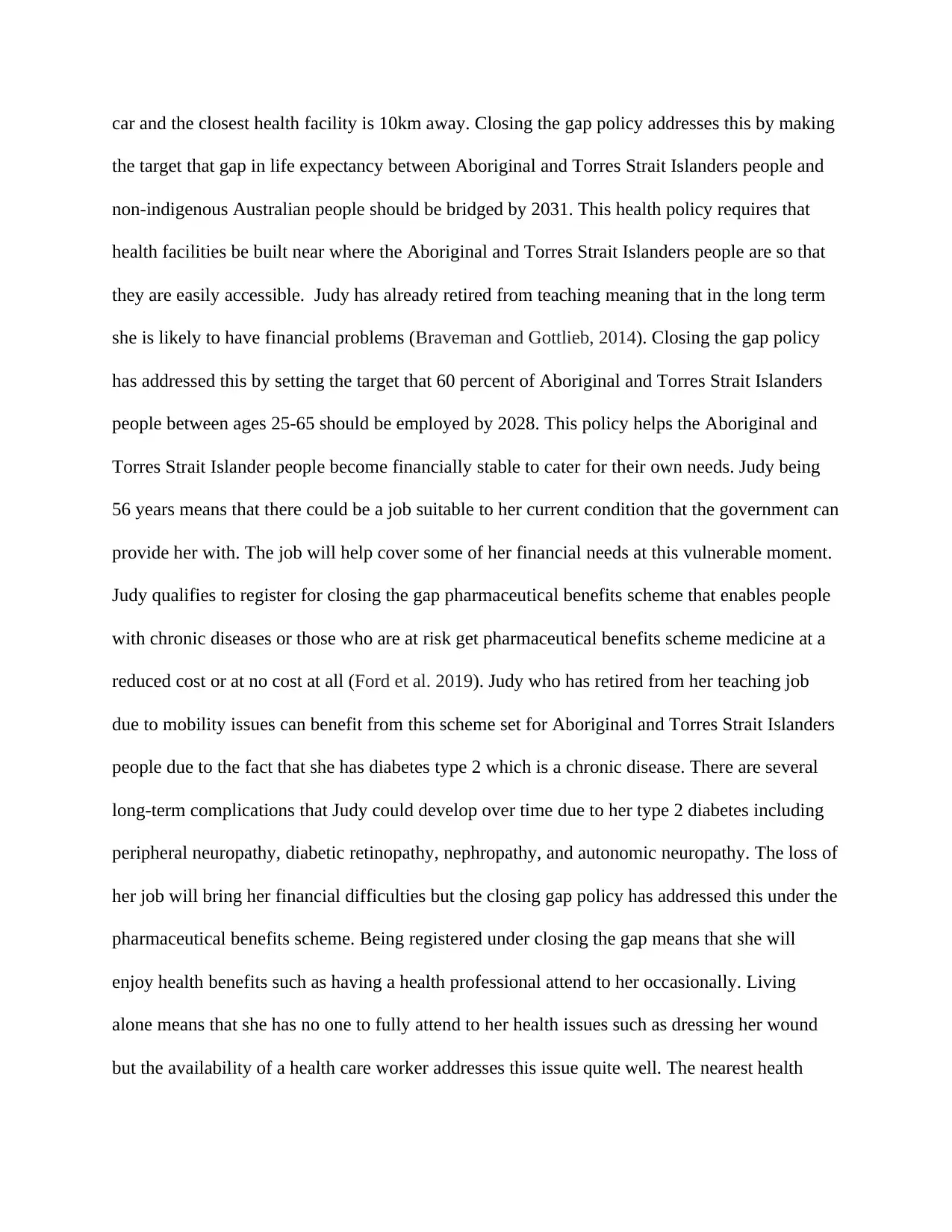
car and the closest health facility is 10km away. Closing the gap policy addresses this by making
the target that gap in life expectancy between Aboriginal and Torres Strait Islanders people and
non-indigenous Australian people should be bridged by 2031. This health policy requires that
health facilities be built near where the Aboriginal and Torres Strait Islanders people are so that
they are easily accessible. Judy has already retired from teaching meaning that in the long term
she is likely to have financial problems (Braveman and Gottlieb, 2014). Closing the gap policy
has addressed this by setting the target that 60 percent of Aboriginal and Torres Strait Islanders
people between ages 25-65 should be employed by 2028. This policy helps the Aboriginal and
Torres Strait Islander people become financially stable to cater for their own needs. Judy being
56 years means that there could be a job suitable to her current condition that the government can
provide her with. The job will help cover some of her financial needs at this vulnerable moment.
Judy qualifies to register for closing the gap pharmaceutical benefits scheme that enables people
with chronic diseases or those who are at risk get pharmaceutical benefits scheme medicine at a
reduced cost or at no cost at all (Ford et al. 2019). Judy who has retired from her teaching job
due to mobility issues can benefit from this scheme set for Aboriginal and Torres Strait Islanders
people due to the fact that she has diabetes type 2 which is a chronic disease. There are several
long-term complications that Judy could develop over time due to her type 2 diabetes including
peripheral neuropathy, diabetic retinopathy, nephropathy, and autonomic neuropathy. The loss of
her job will bring her financial difficulties but the closing gap policy has addressed this under the
pharmaceutical benefits scheme. Being registered under closing the gap means that she will
enjoy health benefits such as having a health professional attend to her occasionally. Living
alone means that she has no one to fully attend to her health issues such as dressing her wound
but the availability of a health care worker addresses this issue quite well. The nearest health
the target that gap in life expectancy between Aboriginal and Torres Strait Islanders people and
non-indigenous Australian people should be bridged by 2031. This health policy requires that
health facilities be built near where the Aboriginal and Torres Strait Islanders people are so that
they are easily accessible. Judy has already retired from teaching meaning that in the long term
she is likely to have financial problems (Braveman and Gottlieb, 2014). Closing the gap policy
has addressed this by setting the target that 60 percent of Aboriginal and Torres Strait Islanders
people between ages 25-65 should be employed by 2028. This policy helps the Aboriginal and
Torres Strait Islander people become financially stable to cater for their own needs. Judy being
56 years means that there could be a job suitable to her current condition that the government can
provide her with. The job will help cover some of her financial needs at this vulnerable moment.
Judy qualifies to register for closing the gap pharmaceutical benefits scheme that enables people
with chronic diseases or those who are at risk get pharmaceutical benefits scheme medicine at a
reduced cost or at no cost at all (Ford et al. 2019). Judy who has retired from her teaching job
due to mobility issues can benefit from this scheme set for Aboriginal and Torres Strait Islanders
people due to the fact that she has diabetes type 2 which is a chronic disease. There are several
long-term complications that Judy could develop over time due to her type 2 diabetes including
peripheral neuropathy, diabetic retinopathy, nephropathy, and autonomic neuropathy. The loss of
her job will bring her financial difficulties but the closing gap policy has addressed this under the
pharmaceutical benefits scheme. Being registered under closing the gap means that she will
enjoy health benefits such as having a health professional attend to her occasionally. Living
alone means that she has no one to fully attend to her health issues such as dressing her wound
but the availability of a health care worker addresses this issue quite well. The nearest health
Secure Best Marks with AI Grader
Need help grading? Try our AI Grader for instant feedback on your assignments.

facility is 10km away and this is stressful to her because of mobility issues arising from the leg
ulcer. Closing the gap provides health care workers who travel to see patients in their homes and
this will help Judy who has mobility issues get treatment at her home (Villarosa et al. 2018).
Closing the gap has ensured that its members registered under the pharmaceutical benefits
scheme can receive their prescriptions anywhere in the country. This has been made possible by
closing the gap ensuring that prescriptions can be annotated by prescribers in Indigenous health
services in both rural and urban centres if they have been approved. This policy fulfills the social
determinant of health access to health services that Judy is in need of considering her current
condition.
Health disparity exists between the Aboriginal and Torres Strait Islanders people and the
non-indigenous and this necessitated the creation of Aboriginal medical services that try and
address this issue of health disparity (Browne et al. 2016). The health disparity experienced by
Aboriginal and Torres Strait Islander people stems from factors such as social imbalance and
poverty experienced by these people. Aboriginal medical services try to address these health
disparity issues by providing medical services that are suitable for the culture of these people as a
substitute for conventional medications. Aboriginal Liaison Officers offer social, emotional and
cultural aid to Aboriginal and Torres Strait Islander people any time they visit the hospital as
patients seeking treatment (De Weger et al. 2018. They help the Aboriginal and Torres Strait
Islanders people connect to health professionals who can assist in the comprehension of medical
procedures so that they can contribute to decisions about their care (De Weger et al. 2018).
Aboriginal medical service and Aboriginal Liaison Officer will be involved in Judy's care
because she comes from the Aboriginal and Torres Strait Islander people. These two were
created to help the Aboriginal and Torres Strait Islander people in matters health and therefore
ulcer. Closing the gap provides health care workers who travel to see patients in their homes and
this will help Judy who has mobility issues get treatment at her home (Villarosa et al. 2018).
Closing the gap has ensured that its members registered under the pharmaceutical benefits
scheme can receive their prescriptions anywhere in the country. This has been made possible by
closing the gap ensuring that prescriptions can be annotated by prescribers in Indigenous health
services in both rural and urban centres if they have been approved. This policy fulfills the social
determinant of health access to health services that Judy is in need of considering her current
condition.
Health disparity exists between the Aboriginal and Torres Strait Islanders people and the
non-indigenous and this necessitated the creation of Aboriginal medical services that try and
address this issue of health disparity (Browne et al. 2016). The health disparity experienced by
Aboriginal and Torres Strait Islander people stems from factors such as social imbalance and
poverty experienced by these people. Aboriginal medical services try to address these health
disparity issues by providing medical services that are suitable for the culture of these people as a
substitute for conventional medications. Aboriginal Liaison Officers offer social, emotional and
cultural aid to Aboriginal and Torres Strait Islander people any time they visit the hospital as
patients seeking treatment (De Weger et al. 2018. They help the Aboriginal and Torres Strait
Islanders people connect to health professionals who can assist in the comprehension of medical
procedures so that they can contribute to decisions about their care (De Weger et al. 2018).
Aboriginal medical service and Aboriginal Liaison Officer will be involved in Judy's care
because she comes from the Aboriginal and Torres Strait Islander people. These two were
created to help the Aboriginal and Torres Strait Islander people in matters health and therefore

she qualifies to receive their services. The community health centres were created to provide
primary health care to the Aboriginal and Torres Strait Islander people under the umbrella of
close the gap campaign (Beks et al. 2019). The health services offered by the community health
centres have to be culturally accepted by these people otherwise it will not be suitable to these
people. It is the duty of the Aboriginal Liaison Officer to make sure that the patients understand
what kind of treatment they are receiving by helping them connect to health care professionals
like the registered nurses working in the community health centres (Caffery et al. 2018).
Conclusion
The release of the social justice report by Aboriginal and Torres Strait Islander people
social justice commissioner Professor Tom Calma in 2005 shed light on injustices faced by these
people. Though the target set by closing the gap campaign have not been achieved there is hope
that many of them will be attained in the near future. The Australian governments need to set
aside more funds so as to aid these campaign for the benefit of the Aboriginal and Torres Strait
Islander People who face several historical unjustnesses. Close working relationships between
the community health centres, the Aboriginal Liaison officer and nurses is fundamental to the
achievement of the health target and should be strengthened.
primary health care to the Aboriginal and Torres Strait Islander people under the umbrella of
close the gap campaign (Beks et al. 2019). The health services offered by the community health
centres have to be culturally accepted by these people otherwise it will not be suitable to these
people. It is the duty of the Aboriginal Liaison Officer to make sure that the patients understand
what kind of treatment they are receiving by helping them connect to health care professionals
like the registered nurses working in the community health centres (Caffery et al. 2018).
Conclusion
The release of the social justice report by Aboriginal and Torres Strait Islander people
social justice commissioner Professor Tom Calma in 2005 shed light on injustices faced by these
people. Though the target set by closing the gap campaign have not been achieved there is hope
that many of them will be attained in the near future. The Australian governments need to set
aside more funds so as to aid these campaign for the benefit of the Aboriginal and Torres Strait
Islander People who face several historical unjustnesses. Close working relationships between
the community health centres, the Aboriginal Liaison officer and nurses is fundamental to the
achievement of the health target and should be strengthened.
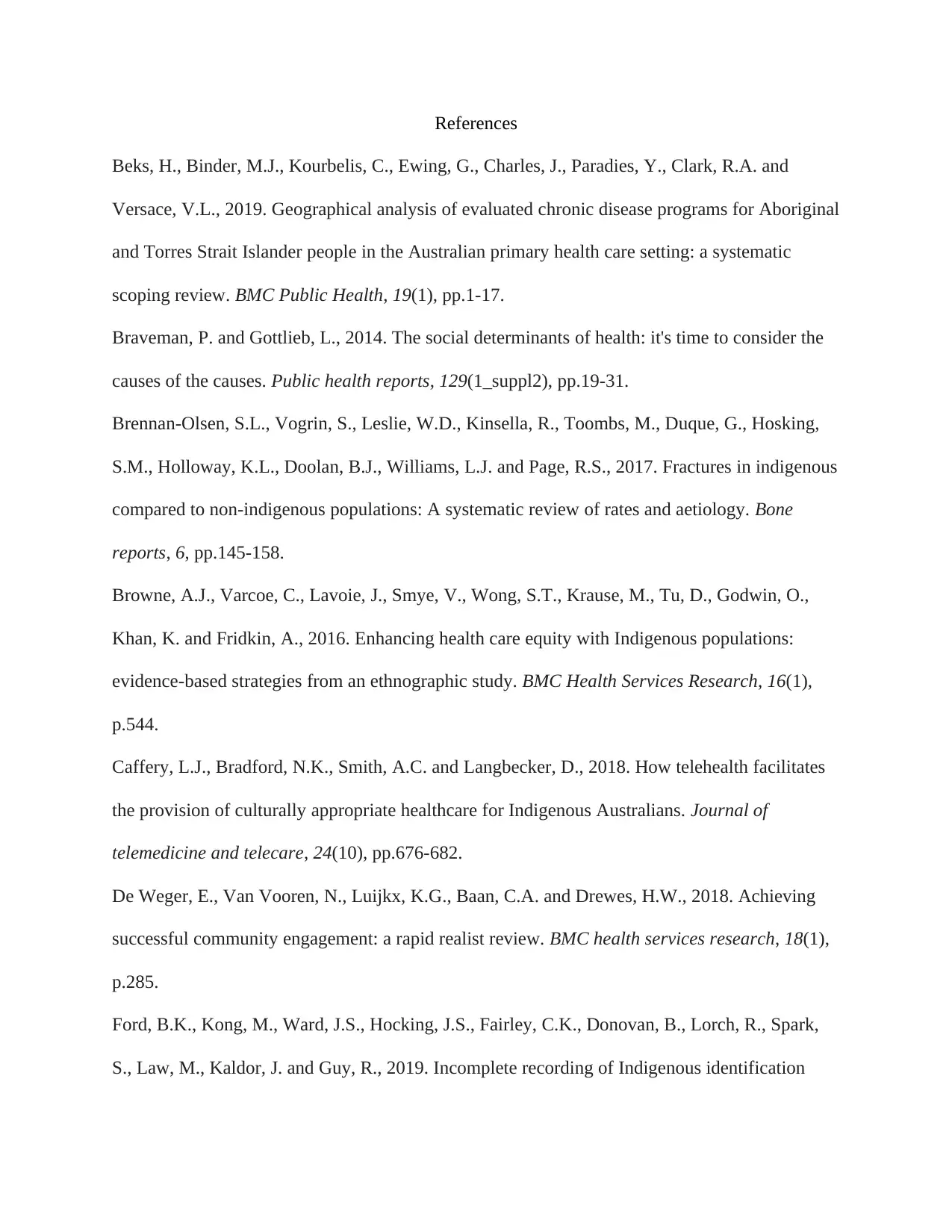
References
Beks, H., Binder, M.J., Kourbelis, C., Ewing, G., Charles, J., Paradies, Y., Clark, R.A. and
Versace, V.L., 2019. Geographical analysis of evaluated chronic disease programs for Aboriginal
and Torres Strait Islander people in the Australian primary health care setting: a systematic
scoping review. BMC Public Health, 19(1), pp.1-17.
Braveman, P. and Gottlieb, L., 2014. The social determinants of health: it's time to consider the
causes of the causes. Public health reports, 129(1_suppl2), pp.19-31.
Brennan-Olsen, S.L., Vogrin, S., Leslie, W.D., Kinsella, R., Toombs, M., Duque, G., Hosking,
S.M., Holloway, K.L., Doolan, B.J., Williams, L.J. and Page, R.S., 2017. Fractures in indigenous
compared to non-indigenous populations: A systematic review of rates and aetiology. Bone
reports, 6, pp.145-158.
Browne, A.J., Varcoe, C., Lavoie, J., Smye, V., Wong, S.T., Krause, M., Tu, D., Godwin, O.,
Khan, K. and Fridkin, A., 2016. Enhancing health care equity with Indigenous populations:
evidence-based strategies from an ethnographic study. BMC Health Services Research, 16(1),
p.544.
Caffery, L.J., Bradford, N.K., Smith, A.C. and Langbecker, D., 2018. How telehealth facilitates
the provision of culturally appropriate healthcare for Indigenous Australians. Journal of
telemedicine and telecare, 24(10), pp.676-682.
De Weger, E., Van Vooren, N., Luijkx, K.G., Baan, C.A. and Drewes, H.W., 2018. Achieving
successful community engagement: a rapid realist review. BMC health services research, 18(1),
p.285.
Ford, B.K., Kong, M., Ward, J.S., Hocking, J.S., Fairley, C.K., Donovan, B., Lorch, R., Spark,
S., Law, M., Kaldor, J. and Guy, R., 2019. Incomplete recording of Indigenous identification
Beks, H., Binder, M.J., Kourbelis, C., Ewing, G., Charles, J., Paradies, Y., Clark, R.A. and
Versace, V.L., 2019. Geographical analysis of evaluated chronic disease programs for Aboriginal
and Torres Strait Islander people in the Australian primary health care setting: a systematic
scoping review. BMC Public Health, 19(1), pp.1-17.
Braveman, P. and Gottlieb, L., 2014. The social determinants of health: it's time to consider the
causes of the causes. Public health reports, 129(1_suppl2), pp.19-31.
Brennan-Olsen, S.L., Vogrin, S., Leslie, W.D., Kinsella, R., Toombs, M., Duque, G., Hosking,
S.M., Holloway, K.L., Doolan, B.J., Williams, L.J. and Page, R.S., 2017. Fractures in indigenous
compared to non-indigenous populations: A systematic review of rates and aetiology. Bone
reports, 6, pp.145-158.
Browne, A.J., Varcoe, C., Lavoie, J., Smye, V., Wong, S.T., Krause, M., Tu, D., Godwin, O.,
Khan, K. and Fridkin, A., 2016. Enhancing health care equity with Indigenous populations:
evidence-based strategies from an ethnographic study. BMC Health Services Research, 16(1),
p.544.
Caffery, L.J., Bradford, N.K., Smith, A.C. and Langbecker, D., 2018. How telehealth facilitates
the provision of culturally appropriate healthcare for Indigenous Australians. Journal of
telemedicine and telecare, 24(10), pp.676-682.
De Weger, E., Van Vooren, N., Luijkx, K.G., Baan, C.A. and Drewes, H.W., 2018. Achieving
successful community engagement: a rapid realist review. BMC health services research, 18(1),
p.285.
Ford, B.K., Kong, M., Ward, J.S., Hocking, J.S., Fairley, C.K., Donovan, B., Lorch, R., Spark,
S., Law, M., Kaldor, J. and Guy, R., 2019. Incomplete recording of Indigenous identification
Paraphrase This Document
Need a fresh take? Get an instant paraphrase of this document with our AI Paraphraser
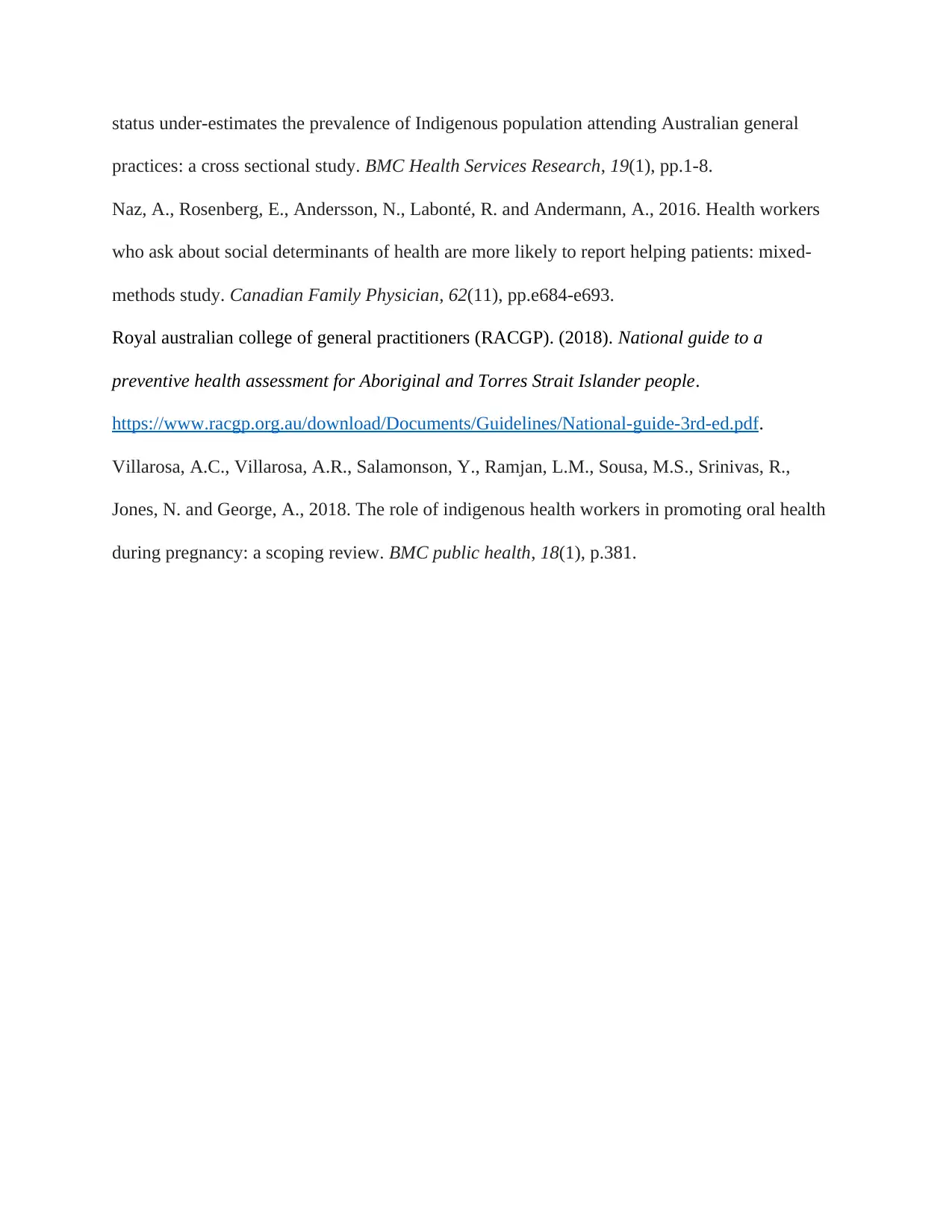
status under-estimates the prevalence of Indigenous population attending Australian general
practices: a cross sectional study. BMC Health Services Research, 19(1), pp.1-8.
Naz, A., Rosenberg, E., Andersson, N., Labonté, R. and Andermann, A., 2016. Health workers
who ask about social determinants of health are more likely to report helping patients: mixed-
methods study. Canadian Family Physician, 62(11), pp.e684-e693.
Royal australian college of general practitioners (RACGP). (2018). National guide to a
preventive health assessment for Aboriginal and Torres Strait Islander people.
https://www.racgp.org.au/download/Documents/Guidelines/National-guide-3rd-ed.pdf.
Villarosa, A.C., Villarosa, A.R., Salamonson, Y., Ramjan, L.M., Sousa, M.S., Srinivas, R.,
Jones, N. and George, A., 2018. The role of indigenous health workers in promoting oral health
during pregnancy: a scoping review. BMC public health, 18(1), p.381.
practices: a cross sectional study. BMC Health Services Research, 19(1), pp.1-8.
Naz, A., Rosenberg, E., Andersson, N., Labonté, R. and Andermann, A., 2016. Health workers
who ask about social determinants of health are more likely to report helping patients: mixed-
methods study. Canadian Family Physician, 62(11), pp.e684-e693.
Royal australian college of general practitioners (RACGP). (2018). National guide to a
preventive health assessment for Aboriginal and Torres Strait Islander people.
https://www.racgp.org.au/download/Documents/Guidelines/National-guide-3rd-ed.pdf.
Villarosa, A.C., Villarosa, A.R., Salamonson, Y., Ramjan, L.M., Sousa, M.S., Srinivas, R.,
Jones, N. and George, A., 2018. The role of indigenous health workers in promoting oral health
during pregnancy: a scoping review. BMC public health, 18(1), p.381.
1 out of 8
Your All-in-One AI-Powered Toolkit for Academic Success.
+13062052269
info@desklib.com
Available 24*7 on WhatsApp / Email
![[object Object]](/_next/static/media/star-bottom.7253800d.svg)
Unlock your academic potential
© 2024 | Zucol Services PVT LTD | All rights reserved.




